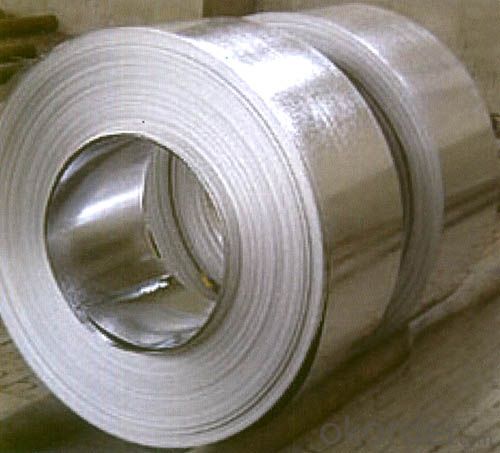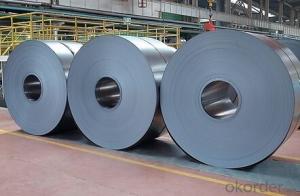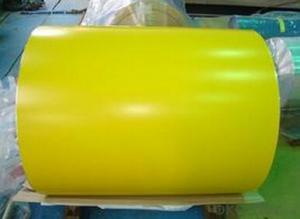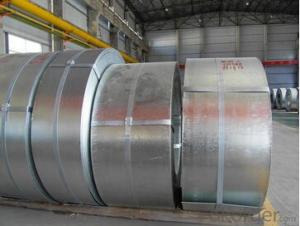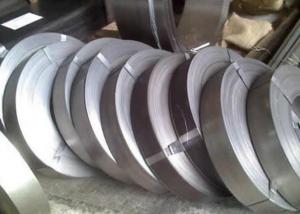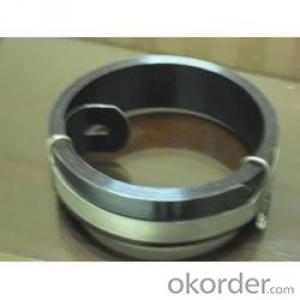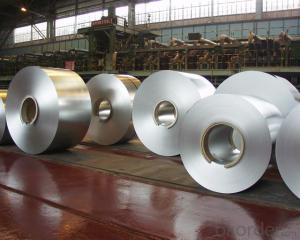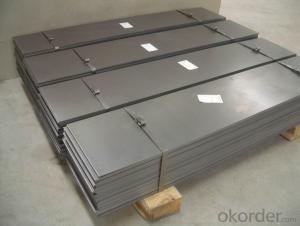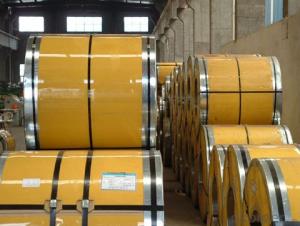Band Steel In Coil
- Loading Port:
- China Main Port
- Payment Terms:
- TT OR LC
- Min Order Qty:
- -
- Supply Capability:
- -
OKorder Service Pledge
OKorder Financial Service
You Might Also Like
Corresponding Steel Grade for Reference:
CHN, GB | JPN, JIS | GER, DIN |
50CrVA | SUP10 | 50CrV4 |
GBR, BS | FRA,FN | |
735A51 | 50CV4 |
Chemical Composition:
C | Si | Mn |
0.46~0.54 | 0.17~0.37 | 0.50~0.80 |
S | P | Cr |
≤0.030 | ≤0.030 | 0.80~1.10 |
Ni | Cu | V |
≤0.35 | ≤0.25 | 0.10~0.20 |
Mechanical Properties:
-Tensile Strength σb (MPa): ≥1274 (130)
-Yield Strength σs (MPa): ≥1127 (115)
-Elongation δ5 (%):≥10
-Percentage reduction of area: ψ (%): ≥40
-Hardness:
1, Hot rolled, ≤321HB
2, Cold drawn + Heat treatment: ≤321HB
-Norm of heat treatment:
1, Quenching: 850℃±20℃.
2, Cooled by oil.
3, Tempering: 500℃±50℃.
Usage/Applications
Mechanical Properties are good. 50CrVA have high hardenability. The element V reduces thermal sensitivity and improves the strength and toughness. The fatigue strength and yield point are high but the weld ability is bad.
-50CrVA is a nice material of spring. Usually it’s used as valve spring, piston spring and secure valve spring with big section that can bear much load. The working temperature is below 300℃
Packaging & Delivery
-Packing Detail: The products will be well packed.
-Delivery Detail: 30~45 working days after receive buyer’s T.T. or L/C.
- Q: What is the fatigue resistance of steel strips?
- The fatigue resistance of steel strips refers to the ability of these strips to withstand repeated cycles of stress or strain without experiencing failure. Steel strips are known for their high fatigue resistance, which makes them suitable for various applications that involve constant or cyclic loading. The fatigue resistance of steel strips depends on several factors, including the composition, microstructure, and surface condition of the steel. Additionally, factors such as the load magnitude, frequency, and duration of the cyclic loading also impact the fatigue resistance. Steel strips are typically designed to have a high fatigue limit, meaning they can endure a large number of stress cycles without failure. This characteristic makes steel strips highly desirable in industries where fatigue failure is a concern, such as automotive, aerospace, construction, and manufacturing. Through proper design, manufacturing processes, and material selection, steel strips can achieve excellent fatigue resistance, ensuring their long-term performance and reliability in demanding applications.
- Q: Are steel strips resistant to impact?
- Yes, steel strips are generally resistant to impact due to their high tensile strength and toughness.
- Q: Are steel strips suitable for decorative purposes?
- Yes, steel strips are suitable for decorative purposes. They can be used to create sleek and modern designs, adding a contemporary touch to various applications such as furniture, wall paneling, and architectural features. Steel's durability, versatility, and ability to be molded into various shapes make it an excellent choice for decorative purposes.
- Q: What are the main applications of steel strips?
- Steel strips possess exceptional properties and versatility, enabling their wide-ranging applications in diverse industries. Notably, steel strips find extensive use in various sectors, as outlined below: 1. Automotive Industry: Within the automotive sector, steel strips play a pivotal role in the production of multiple components such as springs, suspension systems, brackets, reinforcements, and body panels. The inherent strength, durability, and formability of steel strips render them an ideal choice for enhancing the structural integrity and safety of vehicles. 2. Construction Industry: The construction industry relies heavily on steel strips for numerous purposes. These strips are commonly employed in fabricating structural elements like beams, columns, and trusses. Additionally, they are utilized in manufacturing roofing, cladding, and fencing materials. Steel strips ensure the strength, stability, and longevity of structures, thus being an indispensable material in construction projects. 3. Electrical Industry: Steel strips find extensive use in the electrical industry, specifically in the production of electrical transformers and motors. Owing to their magnetic properties, steel strips are optimal for creating efficient and reliable electromagnetic circuits, facilitating the transmission and transformation of electrical energy. 4. Packaging Industry: Steel strips play a crucial role in the packaging industry, being employed for manufacturing metal packaging materials such as cans, drums, and containers. The durability, corrosion resistance, and ease of forming of steel strips make them suitable for safeguarding and preserving a wide array of goods, including food and beverages, chemicals, and other perishable or sensitive products. 5. Manufacturing Industry: The manufacturing industry extensively employs steel strips in various production processes like stamping, forming, and fabrication. These strips are commonly utilized in the manufacturing of appliances, furniture, machinery, and equipment, owing to their high strength, ductility, and ability to be shaped into complex geometries. 6. Aerospace Industry: In the aerospace industry, steel strips find application in the manufacturing of aircraft components and structures. Their exceptional strength-to-weight ratio, corrosion resistance, and heat resistance make them an optimal choice for high-performance materials essential in applications such as aircraft frames, landing gears, and engine components. Overall, steel strips exhibit their utility across multiple industries, including automotive, construction, electrical, packaging, manufacturing, and aerospace. The unique combination of strength, durability, formability, and magnetic properties renders steel strips an indispensable material, contributing to the advancement and progress of modern technology and infrastructure.
- Q: How are steel strips processed for edge conditioning?
- To ensure smooth, burr-free edges suitable for various applications, steel strips undergo a series of steps for edge conditioning. The typical process includes: 1. Slitting: Using a slitting machine, the steel coil is cut into narrower strips of the desired width. This step ensures the strips are the appropriate size for further processing. 2. Deburring: The edges of the steel strips may have burrs or sharp edges from the slitting process. To eliminate these imperfections, the strips are passed through a deburring machine. This machine uses abrasive belts or brushes to grind away the burrs, leaving a smooth, rounded edge. 3. Edge Rolling: After deburring, the steel strips may undergo edge rolling to refine the edge profile. This involves passing the strips through rollers that gradually shape and smooth the edges. It helps eliminate any remaining burrs, sharp corners, or irregularities, resulting in a more uniform edge. 4. Chamfering: Depending on the application, the edges of the steel strips may be chamfered to create a beveled or angled edge. Specialized chamfering machines or tools are used to cut or grind away a small portion of the edge, creating a sloping or angled surface. This chamfered edge improves handling, reduces the risk of damage, and facilitates easier insertion or joining in specific applications. 5. Final Inspection: Once the edge conditioning process is complete, the steel strips undergo a final inspection to ensure they meet the required specifications. This includes visual examination, dimensional checks, and testing for any remaining burrs or sharp edges. If any issues are found, the strips may be reworked or rejected to maintain desired quality standards. Overall, edge conditioning for steel strips involves steps such as slitting, deburring, edge rolling, chamfering, and final inspection. The aim is to produce strips with smooth, burr-free, and well-defined edges that meet the specific requirements of different industries and applications.
- Q: How are steel strips heat treated?
- Annealing or tempering is the process by which steel strips undergo heat treatment, wherein the strips are subjected to controlled cycles of heating and cooling. The main objective of heat treating steel strips is to enhance their mechanical properties, including hardness, toughness, and ductility. During annealing, the steel strips are heated to a specific temperature, typically above their critical temperature, and then gradually cooled. This process alleviates internal stresses, refines the grain structure, and improves the overall machinability of the strips. It also enhances their ductility and toughness, making them more resistant to deformation and cracking. In contrast, tempering involves a similar heating process, but the steel strips are reheated to a lower temperature and then rapidly cooled. This step is performed to reduce the hardness and increase the toughness of the strips. By selecting the appropriate temperature and cooling rate, the desired combination of strength and toughness can be achieved. To ensure consistent and reliable heat treatment results, steel strips are often subjected to heat treatment in controlled atmospheres or furnaces, where the temperature and cooling rate can be precisely controlled. Other factors, such as the steel composition and desired end properties, also influence the specific heat treatment process. Overall, heat treating steel strips is a crucial step in their production process, as it allows for the optimization of their mechanical properties. This makes them suitable for various applications in industries like automotive, construction, and manufacturing.
- Q: How are steel strips hardened and tempered?
- Steel strips are hardened and tempered through a process known as heat treatment. The strips are heated to a specific temperature and then cooled rapidly to achieve hardness. Afterward, they are reheated to a slightly lower temperature and cooled slowly to increase their toughness and reduce brittleness. This process of heat treatment allows steel strips to acquire the desired mechanical properties for various applications.
- Q: How are steel strips polished?
- Steel strips are polished using a process called mechanical polishing, where abrasive materials such as sandpaper or polishing wheels are used to remove imperfections and create a smooth and shiny surface on the steel strips.
- Q: What is the typical corrosion resistance of stainless steel strips?
- The typical corrosion resistance of stainless steel strips is excellent. Stainless steel is known for its ability to resist corrosion and oxidation in various environments. It contains a minimum of 10.5% chromium, which forms a protective layer on the surface, preventing the formation of rust. This chromium oxide layer is self-repairing, making stainless steel highly resistant to corrosion from moisture, acids, and other corrosive substances. Additionally, stainless steel can withstand high temperatures, making it suitable for a wide range of applications where corrosion resistance is crucial, such as in the construction, automotive, and food processing industries.
- Q: How are steel strips processed for temperature resistance?
- Steel strips are processed for temperature resistance through a series of methods and treatments. One common technique is heat treatment, which involves subjecting the steel strips to controlled heating and cooling cycles. This process alters the microstructure of the steel, making it more resistant to thermal deformation and ensuring that it maintains its strength and integrity even at high temperatures. Another method used is alloying, where specific elements are added to the steel composition to enhance its resistance to temperature extremes. For instance, chromium and nickel are often added to create stainless steel, which has excellent resistance to both high and low temperatures. This alloying process modifies the chemical properties of the steel, making it more stable and less prone to oxidation or corrosion at different temperature ranges. Coating the steel strips is also a common approach to improving temperature resistance. This involves applying a protective layer, such as zinc or aluminum, which acts as a barrier against heat and prevents the steel from reaching critical temperatures. Coatings can also provide additional benefits like corrosion resistance and insulation. Furthermore, cold rolling is often employed to increase the strength and toughness of the steel strips. This process involves passing the steel through a series of rollers at room temperature, which not only enhances its mechanical properties but also improves its ability to withstand temperature fluctuations without losing its structural integrity. Overall, the processing of steel strips for temperature resistance involves a combination of heat treatment, alloying, coating, and cold rolling. These techniques ensure that the steel can withstand extreme temperatures, maintain its strength, and resist the detrimental effects of thermal expansion and contraction.
Send your message to us
Band Steel In Coil
- Loading Port:
- China Main Port
- Payment Terms:
- TT OR LC
- Min Order Qty:
- -
- Supply Capability:
- -
OKorder Service Pledge
OKorder Financial Service
Similar products
Hot products
Hot Searches
Related keywords

